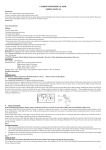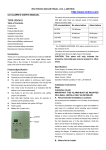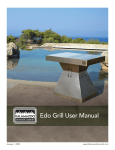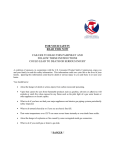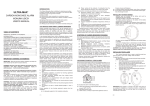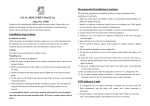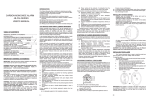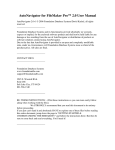Download (BRJ-906LCD SER
Transcript
CARBON MONOXIDE ALARM USER’S MANUAL Introduction Thank you for purchasing the carbon monoxide alarm. This is one Single Station alarm. Please take a few minutes to thoroughly read this user’s guide and save for future reference. Product view to detect CO. Green LED: The green LED flashes every 30 seconds to indicate the unit is operating properly. Red LED: When a dangerous level of carbon monoxide is detected the red LED will flashes and the alarm pattern will sound. The CARBON MONOXIDE (CO) alarm monitors the air for the presence of CO. The alarm will sound and be accompanied by the flashing red LED light when there are high levels of CO presence. CAUTION: This alarm will only indicate the presence of monoxide at the sensor. Carbon monoxide gas may present at other area. Specification: Power Supply: 3×1.5V AA Size batteries. Sensitivity & Time: 50ppm, alarms within 60~90 minutes 100ppm, alarms within 10~40 minutes 300ppm, alarms within 3 minutes Standby Current: <40uA; Alarm Current: <30mA Operation Ambient Condition: -10~400C;20~90%R.H. Features/Specification Features: ·LCD displayer with a blue back ground light. ·Loud 85 decibel alarm. ·Permanent carbon monoxide sensor. ·Compliance with EN50291 standard. ·Powered by 3×1.5V AA size batteries. ·The alarm sound pattern is three short alarm beeps. The red LED will flash while in alarm mode. ·Red LED flashes once every minute together with beep alarm sound is an indication that the battery is low (need replacement). ·Test/Reset button to test the unit electronics and verifies proper unit operation and reset the unit during CO alarm. ·Alarm memory feature: If the unit ever alarms, pressing the button, green LED will flashes once every second for one minute and the peak alarm level will be indicated on the LCD. ·Green and red LED lights that indicate normal operation and alarm status. ·The unit will sound ‘chirp’ and red LED flashes once as power up. ·3 digits LCD displayer is optional. ‘Lo’ on the LCD indicates low battery (need replacement) and ‘OU’ on the LCD to indicate CO level over 999ppm. In normal condition, LCD is be lit for a long time with “0PPM” on the LCD. If the CO leakage is less than 20PPM, it should show “0PPM” on the LCD Displayer. In 4 minutes after the batteries are installed, the unit starts Installation Instructions Step 1 Installation Guide: IMPORTANT: THIS ALARM MUST BE MOUNTED ON A WALL. INSTALL ONLY AS DETAILED! A. Recommended Installation Locations: We recommend the installation of a CO Alarm in the following locations. For maximum protection we suggest an alarm be installed on each level of a multilevel home including every bedroom, hallways, finished attics and basements. Put alarm at both ends of bedroom hallway or large room if hallway or room is more than 30ft. (9.1m) long. If you have only one alarm, ensure it is placed in the hallway outside of the main sleeping area, or in the main bedroom. Verify the alarm can be heard in all sleeping areas. Locate an alarm in every room where someone sleeps with the door closed. The closed door may prevent the alarm from waking the sleeper. Mounting the alarm on the ceiling in the center of the room places it closest to all points in the room. Ceiling mounting is preferred in ordinary residential construction. When mounting an alarm on the ceiling, locate it at a minimum of 4” (10cm) from the side wall (see Diagram A). If installing the alarm on the wall, at a minimum of 4” (10cm) and a maximum of 12”(30.5cm) below the ceiling (see Diagram below). Do not install in garages, kitchens, furnace rooms or bathrooms! INSTALL AT LEAST 15 FEET AWAY FROM ANY FUEL BURNING APPLIANCE. Do not install within 3ft(0.9m) of the following: The door to a kitchen, or a bathroom that contains a rub or shower, forced air ducts used for heating or cooling, ceiling or whole house ventilating fans, or other high air flow areas. Avoid excessively dusty, dirty or greasy areas. Dust, grease or household chemicals contaminate the alarm’s sensors, causing it to not operate properly. Place the alarm where drapes or other objects will not block the sensor. CO must be able to reach the sensors to accurately detect these conditions. Do not install in peaks of vaulted ceiling, ‘A’ frame ceilings or gabled roofs. Keep out of damp and humid areas. Install at least one foot away from fluorescent lights, electronic noise may cause nuisance alarms. Extreme temperatures will affect the sensitivity of the CO Alarm. Do not install in areas where the temperature is colder than 40 degrees Fahrenheit (4.4 Celsius) or hotter than 100 degrees Fahrenheit (37.8 Celsius). Place away from doors and windows that open to the outside. Step 2 Mounting Instructions: 1. Remove the mounting bracket from the back of the alarm by twisting the alarm, then pull out the tab between battery and battery contact to activate the battery. 2. After selecting the proper location for your CO Alarm, drilling two Ø5.0mm holes in the ceiling or wall vertically with the distance of 60mm and inserting two plastic roles into the holes, then attaching the bracket to the plastic role with the arrow down to the ground and screwing tightly two screws in the two roles. 3. Aligning the arrow on the back of the alarm with the arrow on the bracket, then snap the alarm on the bracket by twisting the alarm. Step 3 Testing the Alarm CAUTION: Due to the loudness (85 decibels) of the alarm, always stand an arms length away from the unit when testing. The test/reset button has two purposes. It tests the unit’s electronics and reset the unit during CO alarm. After installation, TEST THE UNITS ELECTRONICS by pressing the test button for five seconds. A series of beeps will sound. The unit needs to be tested weekly! If at anytime it does not perform as described, verify power is connected correctly and that the battery doesn’t need replacing. Clean dust and other buildup off the unit. If it still doesn’t operate properly call our agent. B. Where Not to Install: Operation Instructions Test Feature Press the test button for several seconds to test unit’s 1 electronics. The alarm will sound and LCD will be lit (for the model with LCD). Reset Feature If the alarm is sounding, pressing the button will silence the alarm for several minutes. After the duration, if the CO condition that caused the alert continues, the alarm will reactivate. If the CO level keeps from 70ppm to 200ppm, the duration is around 5 minutes. If the CO level keeps over 200ppm, the duration is zero, i.e. the unit will sound again soon. If the CO level keeps below 70ppm, the unit will not reactivate longer. Alarm Memory Feature If you leave home for long time and during the period the unit ever alarms, after you return and press the button for several seconds, green LED will flashes once every seconds and the peak alarm level will be indicated on the LCD to alert you there is one CO alarm occurs. You should check the possible CO and resolve it. Pressing the button again, the unit will return to normal condition or return to normal condition in one minute automatically. LED indicator Operation Red LED Red Led will flash in conjunction with the alarm beep. Therefore, the red LED will flash during a CO alarm, a low battery mode chirp. As you install the battery on the unit, the unit will sound ‘chirp’ to indicate the battery installed properly, and LCD will indicate ‘888PPM’. Green LED Green LED flashes once every 30 seconds to indicate proper operation. What To Do IF The Alarm Sounds If alarm sounds: 1) Call your emergency services. 2) Immediately move to fresh air – outdoors or by an open door/window. Do a head count to check that all persons are accounted for. Do not reenter the premises nor move away from the open door/window until the emergency services responders have arrived, the premises have been aired out, and your alarm remains in its normal condition. Never restart the source of a CO problem until it has been fixed. NEVER IGNORE THE ALARM! The CO sensor sensitivity and setting is: 50ppm, within 60 to 90 minutes; 100ppm, within 10 to 40 minutes; 300ppm, within 3 minutes. This carbon monoxide alarm is designed to detect carbon monoxide gas from ANY source of combustion. It is NOT designed to detect any other gas. Fire departments, most utility companies will perform CO inspections, some may charge for this service. Battery Replacement If battery failure is detected the unit will ‘chirp’ one time. This cycle will occur once every 30 seconds. CAUTION: YOUR ALARM IS SEALED AND THE COVER IS NOT REMOVABLE! To replace the battery you must first remove the alarm from the mounting bracket, then you can directly replace the battery. After installing or changing the battery, reinstall your alarm. Test your alarm by using the test button and check that the red LED flashing once every 30 seconds. Replace battery with qualified brands. General Maintenance To keep your CO Alarm in good working order, please follow these simple steps: ·Verify the unit’s alarm and LED light operation by pushing the test button once a week. ·Remove the unit from mounting bracket and vacuum the alarm cover and vents with a soft brush attachment once a month to remove dust and dirt. REINSTALL IMMMEDIATELY AFTER CLEANING AND THEN TEST USING THE TEST/RESET BUTTON! ·Never use detergents or other solvents to clean the unit. ·Avoid spraying air fresheners, hair spray, or other aerosols near the CO Alarm. Do not paint the unit. Paint will seal the vents and interfere with the sensor’s ability to detect CO. Never attempt to disassemble the unit or clean inside. This action will void your warranty. WARNING: Reinstall the CO Alarm as soon as possible to assure continuous protection. When household cleaning supplies or similar contaminates are used, the area must be well ventilated. The following substances can affect the CO sensor and may cause false readings and damage to the sensor: Methane, propane, iso-butane, iso-propanol, ethyl acetate, hydrogen sulfide dioxides, alcohol based products, paints, thinner, solvents, adhesives, hair spray, after shave, perfume, and some cleaning agents. Carbon Monoxide Safety Information General CO Information Carbon Monoxide (CO) is a colorless, and tasteless poison gas that can be fatal when inhaled. CO inhibits the blood’s capacity to carry oxygen. Possible Source CO can be produced when burning any fossil fuel: gasoline, propane, natural gas, oil and wood .It Can be produced by any fuel-burning appliance that is malfunctioning, improperly installed ,or not ventilated Correctly. Possible sources include furnaces, gas range/stoves, gas clothes dryers, water heaters, portable fuel Burning space heaters, fireplace, wood-burning, stoves and certain, swimming pool heaters, Blocked chimney or Disconnected vent pipes, and a loose or cracked furnace exchanger can also cause CO. Vehicles and other combustion Engines running in a attached garage and using a charcoal/gas grill or hibachi in an enclosed area are all possible sources of CO. The following conditions can result in transient CO situations: Excessive spillage or reverse venting of fuel-burning appliances caused by outdoor ambient conditions such as: Wind direction and/or velocity, including high gusts of wind heavy air in the vent pipes (cold/humid air with extended periods between cycles), negative pressure differential resulting from the use of exhaust fans, simultaneous operation of limited internal air, ven pipe connections vibrating loose from clothes dryers, furnaces, or water heaters, obstructions in, or unconventional, vent pipe designs which can amplify the above situations, extended operation of unvented fuel-burning devices(range, oven, fire-place, etc),temperature inversions which can trap exhaust gasses near the ground, car idling in an open or closed attached garage, or near a home. CO Safety Tips Every year have the heating system, vents, chimney and flue inspected and cleaned by a qualified technician. Always install appliances according to manufacturer’s instructions and adhere to local building codes. Most appliances should be installed by professionals and inspected after installation. Regularly examine vents and chimneys or improper connections, visible rust, or stains, and check for cracks in furnace heat exchangers. Verify the color of flame on pilot lights and burners is blue. A yellow or orange flame is a sign that the fuel is not burning completely. Teach all household members. what the alarm sounds like and how to respond. Symptoms of CO poisoning Initial carbon monoxide poisoning symptoms are similar to the flu with no fever and can include dizziness, severe headaches, nausea, vomiting and disorientation. Everyone is susceptible but experts agree that unborn babies, pregnant women, senior citizens and people with heart or respiratory problems are especially vulnerable. If symptoms of carbon monoxide poisoning are experienced seek medical attention immediately. CO poisoning can be determined by a carboxyhemoglobin test. The following symptoms are related to CARBON MONOXIDE POISONING and should be discussed with ALL members of the household: 1. Mild Exposure: Slight headache, nausea, vomiting, fatigue (often described as ‘Flu-like’ symptoms). 2. Medium Exposure: Severe throbbing headache, drowsiness, confusion, fast heat rate. 3. Extreme Exposure: Unconsciousness, convulsions, cardiorespiratory failure, death. The above levels of exposure relate to healthy adults. Levels differ for those at high risk. Exposure to high levels of carbon monoxide can be fatal or cause permanent damage and disabilities. Many cases of reported carbon monoxide poisoning indicate that while victims are aware they are not well, they become so disoriented they are unable to save themselves by either exiting the building, or calling for assistance. Also, young children and household pets may be the first effected. Familiarization with the effects of each level is important. 2


